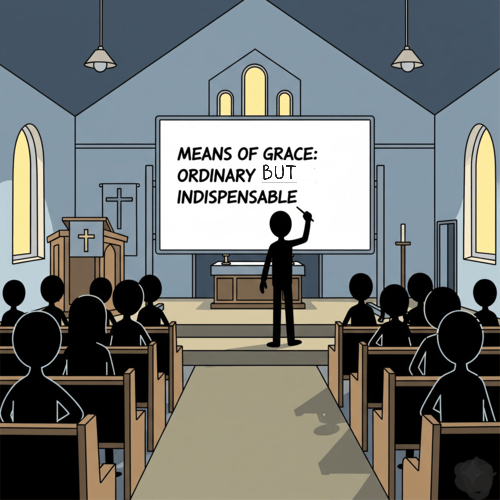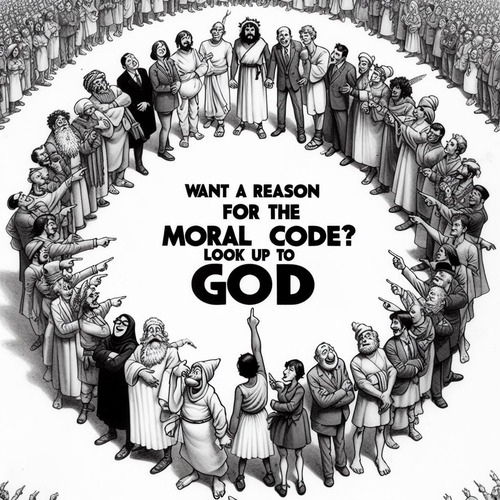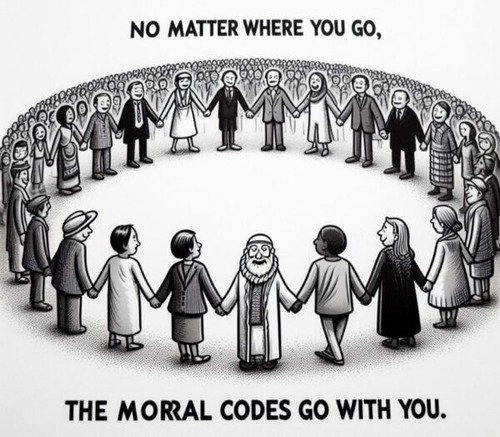Haldane’s Dilemma: Why Can’t Evolution’s Math Add Up?
When a pioneering evolutionary biologist discovers a mathematical problem that challenges the very theory he helped develop, it’s worth paying attention. This is exactly what happened with JBS Haldane, whose mathematical calculations revealed what many consider to be an insurmountable challenge to evolutionary theory—a problem that has since come to be known as Haldane’s Dilemma.
THE MAN BEHIND THE MATHEMATICS
JBS Haldane wasn’t just any scientist. As one of the founders of population genetics and a key figure in the development of the neo-Darwinian synthesis, Haldane dedicated his life to understanding the mechanisms of evolution. His mathematical approach to biology helped establish genetics as a rigorous scientific discipline. Yet, ironically, his calculations led him to discover a fundamental problem that would challenge the very foundation of evolutionary theory.
MAKING SENSE OF THE DILEMMA
At its core, Haldane’s Dilemma is about numbers—specifically, the cost of natural selection. Haldane discovered the process of replacing one gene with another through natural selection carries a significant cost in terms of reproductive capacity and time. The “cost of substitution” means any species can only undergo a limited number of beneficial genetic changes in a given time period.
Here’s the crucial point: Haldane calculated it would take 300 generations to fix just one beneficial mutation in a population. Given the complexity of living organisms and the vast number of differences between species, there simply hasn’t been enough time in Earth’s history for evolution to produce the diversity of life we see today.
THE MATHEMATICAL CHALLENGE
Let’s break this down further. Consider the difference between us and our supposed evolutionary ancestors. The genetic differences would require millions of beneficial mutations to become fixed in the population. Even using the most generous evolutionary timelines, there aren’t enough generations to account for these changes.
For example, let’s assume it’s been six million years since we and chimpanzees shared our alleged common ancestor. Assuming a generation time of 20 years, we get only 300,000 generations. Haldane figured this would only allow for about 1,000 beneficial mutations to be fixed in the population—far fewer than what would be needed to account for the differences between us and chimpanzees.
WHY THIS MATTERS FOR EVOLUTION THEORY
This mathematical limitation creates several major roadblocks for evolutionary theory:
- It shows gradual accumulation of beneficial mutations—the very mechanism Darwin proposed for evolution—cannot work within the available time frame. The cost of substitution would create a temporal bottleneck that no amount of selection pressure can overcome.
- It challenges the notion complex features could evolve through small, incremental steps. Many biological systems require multiple, coordinated changes to function at all. If these changes can’t occur quickly enough, how would such systems ever evolve?
- It highlights the problem of genetic load. Each substitution comes at a reproductive cost to the population, and multiple simultaneous substitutions would create an unsustainable burden.
EVOLUTIONISTS’ ATTEMPTS AT AN ANSWER
Evolutionists have proposed several solutions to Haldane’s Dilemma, but none adequately addresses the core mathematical problem. Some suggest beneficial mutations may become fixed more quickly under certain conditions, while others propose multiple mutations may become fixed simultaneously. However, these proposals either lack empirical support or introduce fresh mathematical problems of their own.
A CREATION PERSPECTIVE
From a creation standpoint, Haldane’s Dilemma makes perfect sense. If life was designed and created in its basic forms, we wouldn’t expect to find a naturalistic mechanism capable of transforming one kind of organism into another. The mathematical limitations Haldane discovered align perfectly with what we would expect in a created world where organisms can adapt within their kinds but cannot transform into entirely different kinds.
The mathematical barrier to large-scale evolutionary change strongly supports the biblical account of creation. It suggests the diversity of life we observe today is better explained by an intelligent Creator who designed organisms with the ability to adapt within prescribed limits, rather than by undirected evolutionary processes.
HALDANE’S DILEMMA—CONCLUSION
Haldane’s Dilemma remains one of the most significant challenges to evolutionary theory. Its importance lies not in complex philosophical arguments or disputed fossil interpretations, but in simple mathematics. The numbers don’t add up for evolution, and no amount of theoretical speculation can overcome this basic fact.
As we consider the implications of Haldane’s work, we’re faced with a choice: either accept a theory that fails mathematical scrutiny, or consider the alternative—that life’s complexity and diversity point to a wise and powerful Creator. The mathematical precision of Haldane’s Dilemma suggests the latter choice aligns far better with the evidence.
HALDANE’S DILEMMA—RELATED FAQS
What recent research supports Haldane’s Dilemma? Recent genetic studies continue to reinforce Haldane’s mathematical concerns. For example, a 2018 study in Nature Genetics examining mutation rates in human populations found beneficial mutations occur at rates far lower than required by evolutionary models, approximately 1-2 beneficial mutations per generation across the entire genome. Additionally, research into genetic load in population genetics has confirmed multiple simultaneous beneficial mutations create unsustainable reproductive costs.
- How does Haldane’s Dilemma impact our understanding of genetic diversity? The mathematical constraints identified by Haldane suggest that generating new functional genetic information faces severe temporal limitations. For instance, studies of human-chimp genetic differences indicate approximately 35 million single nucleotide differences, requiring about 12 million generations to fix under Haldane’s calculations. This far exceeds the proposed evolutionary timeline of 300,000 generations. It makes the observed genetic diversity between species mathematically impossible under conventional evolutionary timeframes.
- What implications does Haldane’s Dilemma have for current scientific discussions? The dilemma significantly impacts discussions about rapid adaptation and speciation. For example, antibiotic resistance in bacteria, often cited as evidence for evolution, typically involves loss or modification of existing genetic information rather than the creation of new information—exactly what we’d expect given Haldane’s mathematical constraints. The cost of selection identified by Haldane helps explain why we observe mostly degenerative changes in real-time genetic studies.
How does Haldane’s Dilemma relate to genetic engineering challenges? Modern genetic engineering efforts frequently encounter limitations that mirror Haldane’s predictions. When attempting to introduce multiple beneficial genetic changes simultaneously, researchers often face unexpected fitness costs and population crashes. For instance, efforts to engineer drought-resistant crops typically succeed only when modifying existing pathways rather than creating new ones, aligning with the limitations Haldane identified.
- What role does Haldane’s Dilemma play in medical research? The dilemma helps explain why certain genetic disorders persist in populations despite negative selection pressures. Studies of human genetic diseases show that even when beneficial mutations arise that could theoretically counter genetic disorders, they rarely become fixed in populations at the rates required by evolutionary models. This understanding has practical implications for genetic therapy approaches.
- How do mutation accumulation studies support Haldane’s calculations? Recent studies tracking mutation accumulation in human populations indicate we acquire approximately 100-200 new mutations per generation, with the vast majority being neutral or slightly deleterious. Given Haldane’s cost calculations, even if 1% of these mutations were beneficial (an optimistic estimate), populations could not sustain the selection cost of fixing them all. This matches real-world observations of genetic decline rather than improvement in many species.
What does the fossil record reveal about Haldane’s predicted limitations? The fossil record shows patterns consistent with Haldane’s mathematical constraints—notably, the sudden appearance of complex forms without clear transitional sequences. For example, the Cambrian Explosion exhibits the rapid appearance of most major animal body plans within a geologically brief period (about 25 million years), without the gradual accumulation of changes that evolutionary theory would predict. This aligns with Haldane’s calculations showing the impossibility of such rapid multiple genetic changes.
HALDANE’S DILEMMA—OUR RELATED POSTS
Editor's Pick

Paul’s Mandate for Men: Headship Or Servant Leadership? Or Both?
Modern Christianity has fallen into a trap. We've created an either/or battle between "headship" and "servant leadership," as if these [...]

Should We Stop Using Male Pronouns for God? Why Do We Say No?
A friend of ours arrived eagerly at his first theology class in seminary. But he quickly discovered something troubling: the [...]

Did Old Testament Law Force Women to Marry their Rapists?
**Editor’s Note: This post is part of our series, ‘Satan’s Lies: Common Deceptions in the Church Today’… Viral misinformation abounds [...]

From Danvers To Nashville: Two Statements, One Biblical Vision
30 years separate the Danvers Statement on Biblical Manhood and Womanhood (1987) and the Nashville Statement on Human Sexuality (2017). [...]

The Nashville Statement: Why Affirm It Despite Media Backlash?
WHY DO REFORMED CHRISTIANS STAND BY THIS STATEMENT ON MARRIAGE AND GENDER? When the Nashville Statement was released in 2017, [...]

Who Is Belial? Solving The 2 Corinthians 6:15 Mystery
Belial: This name from the pages of Scripture chills the soul. Who is this mysterious figure Paul invokes in 2 [...]

Celibacy Or Castration: What Jesus Really Means in Matthew 19:12
One of Scripture's most shocking misinterpretations led theologian Origen to castrate himself in the third century. His tragic mistake? Taking [...]

Philippians 4:13: Did Paul Really Mean We Can Do ALL Things?
"I can do all things through Christ who strengthens me." It's on gym walls, graduation cards, and motivational posters everywhere. [...]

The Ordinary Means of Grace: Why Are They Indispensable?
ORDINARY MEANS FOR EXTRAORDINARY TRANSFORMATION What if God's most powerful work in believers' lives happens through the most ordinary activities? [...]

Is the Bible God’s Word? Or Does It Only Contain God’s Word?
The authority of Scripture stands at the crossroads of modern Christianity. While some argue the Bible merely contains God’s Word [...]
SUPPORT US:
Feel the Holy Spirit's gentle nudge to partner with us?
Donate Online:
Account Name: TRUTHS TO DIE FOR FOUNDATION
Account Number: 10243565459
Bank IFSC: IDFB0043391
Bank Name: IDFC FIRST BANK






